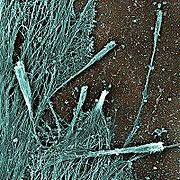
Filopodia
Encyclopedia

Lamellipodia
The lamellipodium is a cytoskeletal protein actin projection on the mobile edge of the cell. It contains a quasi-two-dimensional actin mesh; the whole structure propels the cell across a substrate...
in migrating cells. They contain actin filaments cross-linked into bundles by actin-binding proteins, e.g. fascin
Fascin
Fascin is a actin cross-linking protein.It is a 54-58 kilodalton monomeric actin filament bundling protein originally isolated from sea urchin egg but also found in Drosophila and vertebrates, including humans. Fascin is spaced at 11 nanometre intervals along the filament...
and fimbrin. Filopodia form focal adhesions with the substratum, linking it to the cell surface. Many types of migrating cells
Cell (biology)
The cell is the basic structural and functional unit of all known living organisms. It is the smallest unit of life that is classified as a living thing, and is often called the building block of life. The Alberts text discusses how the "cellular building blocks" move to shape developing embryos....
display filopodia, which are thought to be involved in both sensation of chemotropic cues, and resulting changes in directed locomotion.
Activation of the Rho family of small Ras-related GTPase
GTPase
GTPases are a large family of hydrolase enzymes that can bind and hydrolyze guanosine triphosphate . The GTP binding and hydrolysis takes place in the highly conserved G domain common to all GTPases.-Functions:...
s, particularly cdc42
CDC42
Cell division control protein 42 homolog also known as CDC42 is a protein involved in regulation of the cell cycle. In humans, CDC42 is encoded by the CDC42 gene.- Function :...
and their downstream intermediates results in the polymerization of actin fibers by Ena/Vasp homology proteins
Ena/Vasp homology proteins
ENA/VASP Homology proteins or EVH proteins are a family of closely related proteins involved in cell motility in vertebrate and invertebrate animals. EVH proteins are modular proteins that are involved in actin polymerisation, as well as interaction with other proteins...
. Growth factors bind to receptor tyrosine kinases resulting in the polymerization
Polymerization
In polymer chemistry, polymerization is a process of reacting monomer molecules together in a chemical reaction to form three-dimensional networks or polymer chains...
of actin
Actin
Actin is a globular, roughly 42-kDa moonlighting protein found in all eukaryotic cells where it may be present at concentrations of over 100 μM. It is also one of the most highly-conserved proteins, differing by no more than 20% in species as diverse as algae and humans...
filaments, which, when cross-linked, make up the supporting cytoskeletal
Cytoskeleton
The cytoskeleton is a cellular "scaffolding" or "skeleton" contained within a cell's cytoplasm and is made out of protein. The cytoskeleton is present in all cells; it was once thought to be unique to eukaryotes, but recent research has identified the prokaryotic cytoskeleton...
elements of filopodia. Rho activity also results in the activation of the phosphorylation of the ezrin-moesin-radixin group promoting the binding of actin
Actin
Actin is a globular, roughly 42-kDa moonlighting protein found in all eukaryotic cells where it may be present at concentrations of over 100 μM. It is also one of the most highly-conserved proteins, differing by no more than 20% in species as diverse as algae and humans...
filaments to the filopodia membrane.
To close a wound in vertebrates, growth factors stimulate the formation of filopodia in fibroblasts to direct fibroblast
Fibroblast
A fibroblast is a type of cell that synthesizes the extracellular matrix and collagen, the structural framework for animal tissues, and plays a critical role in wound healing...
migration and wound closure. In developing neurons, filopodia extend from the growth cone
Growth cone
A growth cone is a dynamic, actin-supported extension of a developing axon seeking its synaptic target. Their existence was originally proposed by Spanish histologist Santiago Ramón y Cajal based upon stationary images he observed under the microscope...
at the leading edge. In neurons deprived of filopodia by partial inhibition of actin filaments
Actin
Actin is a globular, roughly 42-kDa moonlighting protein found in all eukaryotic cells where it may be present at concentrations of over 100 μM. It is also one of the most highly-conserved proteins, differing by no more than 20% in species as diverse as algae and humans...
polymerization, growth cone extension continues as normal but direction of growth is disrupted and highly irregular. In macrophages, filopodia act as phagocytic tentacles and pull bound objects towards the cell for phagocytosis.
Filopodia are also used for movement of bacteria between cells, so as to evade the host immune system. The intracellular bacteria Ehrlichia are transported between cells through the host cell filopodia induced by the pathogen during initial stages of infection.

